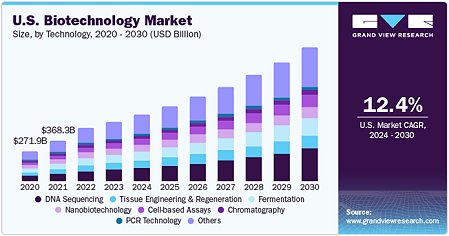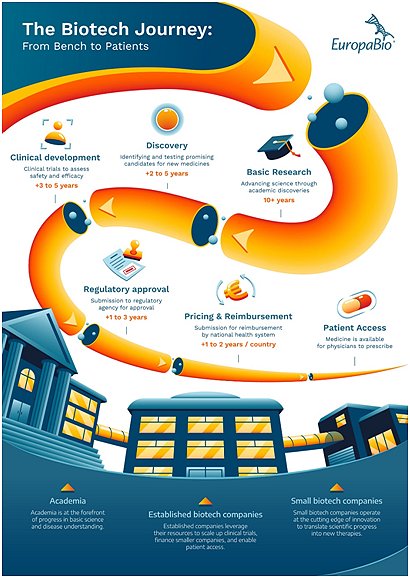
Stone Washington

Successful biotech entrepreneurs recount how a favorable corporate-pharma ecosystem facilitated pathbreaking research that introduced novel medicines
“This book will be a useful resource for management students and scholars, biomedical scientists, venture capitalists, and other investors, entrepreneurs, healthcare policymakers, and all others interested in how new medicines come into being, why the process is so breathtakingly expensive, and how small entrepreneurial ventures can compete in one of the world’s most expensive and heavily regulated industries.”
~From Chapter 1, pg. 8.
From Breakthrough to Blockbuster: The Business of Biotechnology, by Donald L. Drakeman; Lisa N. Drakeman; Nektarios Oraiopoulos (Oxford University Press, 224 pp., $30)
Donald L. Drakeman’s 2022 book, From Breakthrough to Blockbuster: The Business of Biotechnology, provides an expert perspective on the remarkable rise of the biotech industry in the U.S. Adopting a biblical “David v. Goliath” paradigm for biotech v. “Big Pharma”, Drakeman speaks to how start-up biotechnology firms with limited manpower and resources were able to effectively compete against more established and better experienced pharmaceutical companies. By defying the odds, biotech companies have emerged as the efficient, entrepreneurial alternative for producing cost-saving drugs in the market, disrupting the corporate-pharma dominance during the last 50 years.
Drakeman, alongside co-authors Lisa N. Drakeman and Professor Nektarios Oraiopoulos, issue the first reappraisal of the productive success of biotechnology in 15 years. Cutting against the grain of prevailing views made by Harvard Business Professor Gary Pisano that biotech innovation is a risky venture and “lost cause”, Drakeman’s work unveils the revolutionary success of biotech firms thriving within an ambiguous, high risk, research-intensive environment.
Biotech companies continually operate at a disadvantage in the market. Despite managing less than fifty employees, lacking expensive technologies, and possessing comparatively lower revenue streams, many biotech firms have surpassed their pharmaceutical counterparts by providing more efficient and cost productive products to the market. This outperformance was made evident by an FDA analysis finding that biotech firms provided 40% more crucially important, affordably produced medicines to remedy unmet medical ailments between 1998-2016. Drakeman’s book is perhaps the first to explore the broader “biotech ecosystem”, a confluence of academic researchers, venture capitalists, contract research firms, domestic capital markets, and existing pharmaceutical companies that provide the landscape for biotech innovation.
How can emergent biotech firms possibly survive in one of the world’s most highly regulated, extremely expensive, and research-intensive industries? Drakeman posits that the relative disadvantages of the hundreds of small biotech firms can be offset by the preferential ecosystem stimulating their productive advantage. Biotech firms play an indispensable role in the developmental market of new medicines, introducing restorative new treatments to remedy a host of cancers, diseases, and hereditary disorders that were previously uncurable.
In a “do or die” environment where only 10% of introduced medicines are approved for clinical use, a critical component for biotech success can be found through courting private investors. This has fostered a diverse arena of risk-taking competitors introducing robust new medicines that are financed by thousands of reliable investments and refined by a painstaking process of trial and error. As the authors find, what drives such entrepreneurial success in the biotech ecosystem is its privatized, underregulated structure. This competitive realm of investing and innovation “fosters the high volume of risk-taking that enhances the development of genuinely novel products in an environment characterized by many unknown unknowns,” (pg. 11).

Biotechnology lies at the intersection of biological sciences and technological invention. Among the many patented medicines introduced over the last 50 years, two of the most successful biotechnologies—monoclonal antibodies and recombinant DNA—have stood the test of time. Drakeman describes recombinant DNA as the process of transmitting a cloned genetic sequence into an organism, which reengineers its DNA to manufacture the human molecule. This form of DNA sequencing has been successfully used to revitalize scores of depleted white blood cells harmed by chemical poisoning; such cells essentially provide a firewall against most forms of cancer.
Monoclonal antibodies were first introduced by scientists in Cambridge as a specialized form of proteins scientifically produced to mimic natural proteins. These monoclonal antibodies are equipped to detect and target specific viruses, drawing in killer cells like a dragnet. By allowing itself to be consumed by the germs, the antibodies disseminate a curative treatment that spreads across the individual’s immune system. Monoclonal antibodies have been most effective in eradicating HER-2 upon being deployment of the Hereceptin antibody to eradicate the growth of tumors. Where recombinant DNA can be utilized to create more of a positive molecule, monoclonal antibodies can be weaponized to eliminate or inactivate harmful ones.

In an environment defined by extremely expensive medical technologies and high FDA denial rates, biotech companies shoulder the lion’s share of risks when squared with their pharmaceutical rivals. With that in mind, biotech firms exhaust an incredible amount of time and resources to advance “one or more (and rarely more than a few) potential medicines through the lengthy process ending in FDA approval and commercia launch.”
One of the most pivotal legislative measures that spurred the biotech revolution in the 1980’s was the Bayh-Dole Act, allowing for universities to patent their own biotechnology discoveries. A portion of the bio-tech proceeds are retained by the university based on the terms of their licensing agreement with partnered biotech firms.
The Bayh-Dole Act helped spur a massive development of biomedical research in life sciences, leading to a cascade of technology transfers between universities and biotech companies. Beyond the academic market for biotech developments, a key factor at the funding stage lies with the entrepreneurial backing of venture capital firms. Venture capitalists are intimately involved with the story promotion, multi-round funding, and partnership brokering that is instrumental in elevating the success of biotech.
The underlying goal for most venture capital firms is to ensure that their financial investment, no matter how risky, will translate into some lucrative exit strategy. The aim is to either sell the biotech firm to a larger biotech company, pharmaceutical giant, or go public with the company’s stock. The public sector accounts for the largest share of raised funding, while the private sector possesses the largest number of biotech firms. Much like the combination of “money and molecules” venture capital and academic support for biotech development goes hand-in-hand, as universities with large endowments often serve as a back-up source of funding whenever private capital becomes dried up.

Research development can benefit from competitive alliances struck between pharma and biotech industries. Given the highly regulated environment for pushing through new therapeutic products and the vast sea of uncertainty that comes with navigating new innovations, biotech firms must rely on a diverse arrangement of concerned stakeholders to ensure a greater chance for success. These parties include, government agencies, corporate sponsors, physicians, affected patients, and human resource personnel, all of whom facilitate the entrepreneurial journey for introducing biotech products into the market. Each of these involved groups undergird the biotech ecosystem.
In chapter 7, authors address one of the distinctive traits that explains why biotech firms produce more pathbreaking medical remedies than their larger, better funded pharmaceutical rivals. The secret, according to Drakeman, lies in how biotech companies are strategically managed relative to big pharma, possessing a greater capacity for allocating scarce resources to various research programs, which in turn maximize positive results. As a result, biotech firms are better positioned to withstand varying levels of risk by disseminating available resources across their research centers in a polycentric approach, each facing their own set of risks and operating responsibilities. For the pharmaceutical industry, decision-making often concentrates around a small group of the largest companies with oligopolistic control of the research and design funding apparatus. Their select committees are tasked with crafting budgets that allocate available funding.
The decentralized biotech industry thrives from facilitating dispersed competition over available funding between thousands of independent firms seeking lucrative investments from thousands of eager investors. Another distinction between biotech and pharma is in how biotech firms find a way to successfully introduce novel innovative remedies in the midst of highly ambiguous and risky circumstances. “It is this combination of thousands of independent biotech companies being funded through the independent decisions of thousands of investors (which, together, we refer to as the biotech ecosystem) that has created a model for decentralized drug development based on parallel search,” (pg. 142).

One element that undermines the approach taken by many large pharmaceutical companies is what is denoted as “technological myopia”, an inclination to utilize only a select few technologies that closely resemble their existing product lines, while ignoring the wide range of alternatives. Where pharma executives are more risk averse and rigidly constrained by their internal biases on what is the right v. wrong approach for drug development, biotech officials aren’t unrestrained by such biases, instead improvising their approaches as they advance development.
Public policy that favors the spontaneous innovation of emergent bio-technology fosters a plethora of benefits, such as novel academic research, private equity, and healthcare innovation that reverberate into other sectors of the market. Essential to preferable biotech policy are regulatory mechanisms that must invite (not deter) private capital from willing investors. Many successful private investments generate an “economic multiplier” effect by enhancing a state’s return on investment into a biotech product. According to case studies on biotech funding in California and New Jersey, private capital can often outpace public funding by the host state, while saving billions in healthcare costs through providing efficient therapeutic pathways, such as new stem cell treatments.
When looking to the future of the biotech industry, the authors are confident that private capital will continue to serve as a profitable booster to undergird public biotech funding. The unfortunate side effect for such a capital-intensive environment is that much of the cost will be borne upon private investors and healthcare patients through associated fees.
With no reasonable cost-saving measure in sight, the best solution is to introduce more efficient products to streamline the approval process for curative medicines. Shortening the extensive drug approval process without sacrificing efficiency of outcome can assist this. This requires a federal regulatory regime that is favorable to the competitive ecosystem of private investors, universities, biotech firms, partnered pharmaceuticals all working in unison to spur pathbreaking new products in the marketplace. This is the business of biotechnology.

The views expressed by RenewAmerica columnists are their own and do not necessarily reflect the position of RenewAmerica or its affiliates.



















